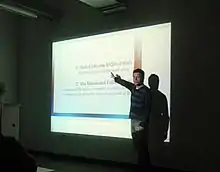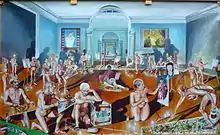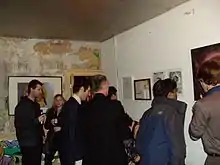Intentism
Intentism is "among the important art movements of the 21st century" [1] founded by Vittorio Pelosi.[2] Intentists include Professor of Philosophy Paisley Livingston, author of Art and Intention,[3] and Professor of Philosophy William Irwin, author of Intentionalist Interpretation.[4] Intentism is a "reaction against the de-emphasis of the author intentionalism in the latter portion of the 20th century – which claims that the meaning of the work is found in the author’s intention and not the interpretation of the viewer." [5] Intentists have staged various exhibitions[6] and have spoken at Universities[7] including the University of the Arts London. In 2009 their manifesto was published in Intentism - The Resurrection of the author.[8]
Name and origin
Intentists come from a variety of backgrounds but are all questioning ideas related to the meaning of work.[9] The name Intentism is a response to the debate around authorial intent.[10] In the public debates that launched intentism, Vittorio Pelosi cited four key schools that the new movement sought to challenge. These include the so-called "The Intentional Fallacy" published by Monroe Beardley and William Wimsatt, which maintained that "The design or intention of the author is neither available nor desirable as a standard for judging the success of a work of literary art."[11] There is also the case of the French philosopher Roland Barthes, who, in 1967, declared that the author is dead and that his work is nothing but a "tissue of quotations" and that the impression of the reader is more important.[11] He also cited Jacques Derrida's deconstruction theory, which critiques the relationship of text and meaning, and exposes meaning that run counter to what was intended by the author. Finally, Pelosi identified Hans-Georg Gadamer's theory that a text's meaning can change over time due to the changes that transpire in society. According to the thinker, these theories are outdated and that there is an imperative to identify, celebrate, and recognize the relationship between the artist and his creation because "all meaning is the imperfect outworking of intention."[11]
Manifesto
Intentists believe that art can convey an artist's intended message to his or her intended audience. Artist intentions are ‘performance expectations’ that if met by the work, is considered a ‘realized intention.’ [12] a movement it both recognizes and celebrates the relationship between an artist's creation and its creator.[13]/>
Intentists believe three principles:[14]
- Intentists believe that the artist is free to convey his or her intended message. The meaning of the work is found in the artist's intention and not the interpretation of the viewer. All meaning is simply the imperfect outworking of intention.[10]
- Intentists believe a confused, hidden or denied intention leads to zero accountability.
- Intentists believe that an omission of artist intention can lead to enforced restrictions on the artist and even censorship.
Public debates and lectures
Intentism has been the subject of several public debates. In 2009 The University of the Arts London held a Panel Discussion around Intentism entitled 'Intentism: Is an artist free to convey his or her intended message?[15] In 2011, The Royal College of Art, held a debate on Intentism named 'Rebirth of the Author?'[16] Intentists have also given several Lectures at various art institutions including The University of East London[17] and the University of Kent.

Artistic practice
Intentist artists work in numerous ways, but at present there appears to be three areas that are of particular interest. Firstly, Intentists often celebrate the artist's intentions in the work by including the entire process of creating art in the final piece. Consequently, elements of every editing decision is left in.[18] Intentists call this process Palimpsestism "where the resolved work is clearly distinguishable from the work in progress"[19] and the Creative Trail since "during the course of a creative work, an artist will have multiple intentions, including a meta-intention of the overall work and many micro-intentions as the art progresses."[20] Secondly, since authorial irony can only be understood by comparing what is said (the work), and what is meant (author intent), it is a common subject for Intentist artists. An example here would be Luciano Pelosi’s Big Breakfast. Thirdly, much art theory finds its origin in Literary theory. It is a claim of the Intentists that in certain fundamental areas this cross over is not valid. In literature the author has a linear order expectation for the text since the viewer will normally start at the beginning and read letters sequentially until the end. However, this approach is not appropriate for the static arts. Most paintings and sculptures are anarrative as viewers can approach the work in multiple orders. Therefore, this basis for ignoring the artist’s intentions is not relevant. An example of an Intentist artist creating work to demonstrate these anarrative properties is Govinda Sah.[21]
The School of Postmodernism

Vittorio Pelosi's painting The School of Postmodernism, inspired by Raphael's The School of Athens, is one of the best known paintings to come out of the Intentist movement and replaces all of Raphael's Athenian philosophers with Postmodern icons. Each figure is attempting an objective depiction of the life model, but their work is subjected to their postmodernist ideologies.[22]
Exhibitions
Intentists regularly exhibit their work, both in solo Intentist exhibitions and Intentist group shows.[23]

References
- [https://issuu.com/familyofficeelitemagazine/docs/art-museum-autumn-17-single
- www.vittoriopelosi.webs.com
- www.amazon.com. ASIN 0199204292.
- "www.amazon.com".
- [https://ses.library.usyd.edu.au/handle/2123/13421
- "1stAngel Arts – Life in and around the arts today". 1stangel.co.uk.
- "University of the Arts London Alumni Bulletin". Archived from the original on 2011-09-28. Retrieved 2010-01-22.
- www.amazon.com. ASIN 0956276806.
- "Intentism". Intentism.
- "Culture Wars - Intentism – the Resurrection of the Author". www.culturewars.org.uk.
- Pelosi, Vittorio (2011). Intentism: Public Debates 2009- 2011. Intentism Publishing House. pp. 15–16. ISBN 9781326730598.
- [http://search.proquest.com/openview/42f9a0d3d4068a350497988455fbb691/1?pq-origsite=gscholar&cbl=18750&diss=y
- "Sant, Tony (2017)Documenting Performance". www.bloomsbury.com.
- "Archived copy". Archived from the original on 2011-09-28. Retrieved 2010-01-22.CS1 maint: archived copy as title (link)
- "Intentism". Intentism.
- "1stAngel Arts – Life in and around the arts today". 1stangel.co.uk.
- "Sant, Tony (2017) Documenting Performance". www.bloomsbury.com.
- "Sant, Tony (2017)Documenting Performance". www.bloomsbury.com.
- "Govinda 'Sah' Azad". govindasah.com.
- "Intentism". Intentism.
- "Intentism". Intentism.
External links
Further reading
- Burke, S (2010) The Death and Return of the Author: Criticism and Subjectivity in Barthes, Foucault, and Derrida Edinburgh University Press, ISBN 0-7486-3711-7 ISBN 978-0748637119
- Gibbs, R.W. (1999) Intentions in the Experience of Meaning Cambridge University Press,ISBN 0-521-57630-X ISBN 978-0521576307
- Hirsch, E.D.Jnr. (1967) Validity in Interpretation Yale University Press, ISBN 0-300-01692-1 ISBN 978-0300016925
- Irwin, W.(1999) Intentionalist Interpretation: A Philosophical Explanation and Defense Praeger, ISBN 0-313-31151-X ISBN 978-0313311512
- Irwin, W. (2002) The Death and Resurrection of the Author? (Contributions in Philosophy) Greenwood Press, ISBN 0-313-32275-9 ISBN 978-0313322754
- Juhl, P.D. (1986) Interpretation: An Essay in the Philosophy of Literary Criticism Princeton University Press, ISBN 0-691-02033-7 ISBN 978-0691020334
- Krausz, M (2002) Is There a Single Right Interpretation? Pennsylvania State Univ Pr, ISBN 0-271-02183-7 ISBN 978-0271021836
- Livingston, P. (2007) Art and Intention: A Philosophical Study Clarendon Press, ISBN 0-19-920429-2 ISBN 978-0199204298
- Lyas, C (2007) Aesthetics (Fundamentals of Philosophy) Taylor and Francis, ISBN 1-85728-580-8 ISBN 978-1857285802
- Pelosi, V (2009) Intentism: Resurrection of the Artist Intentism Publishing House, ISBN 0-9562768-0-6 ISBN 978-0956276803
- Stecker, R (2003) Interpretation and Construction: Art, Speech, and the Law Wiley-Blackwell, ISBN 1-4051-0175-X ISBN 978-1405101752
